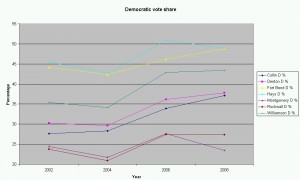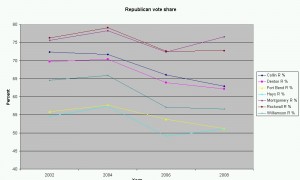Matt Stiles looks at Census data and notes a political point.
Seven Texas counties — Rockwall, Williamson, Collin, Hays, Fort Bend, Montgomery and Denton — are listed among the nation’s 30 fastest-growing areas, according to U.S. Census Bureau estimates released [Tuesday].
They are also Republican-voting counties, according to results in the 2008 general election. Sen. John McCain won these counties by a 20-point margin, well over 240,000 votes.
It’s actually a hair shy of 260,000 votes – Stiles had missed Rockwall County in his initial post, and though he added it in for an update, he did not re-do the math. There’s a bit more to this than that, however. Let’s have a look at how these counties voted in 2004:
County Name Party Votes Total Pct ==================================================== Collin Bush R 174,435 243,370 71.67 Collin Kerry D 68,935 243,370 28.33 Denton Bush R 140,891 200,237 70.36 Denton Kerry D 59,346 200,237 29.64 Fort Bend Bush R 93,625 162,347 57.67 Fort Bend Kerry D 68,722 162,347 42.33 Hays Bush R 27,021 47,131 57.33 Hays Kerry D 20,110 47,131 42.67 Montgomery Bush R 104,654 133,282 78.29 Montgomery Kerry D 28,628 133,282 21.71 Rockwall Bush R 20,120 25,440 79.09 Rockwall Kerry D 5,320 25,440 20.91 Williamson Bush R 83,284 126,401 65.89 Williamson Kerry D 43,117 126,401 34.11 Total Bush R 644,030 938,208 68.64 Total Kerry D 294,178 938,208 31.36 Total McCain R 699,183 1,139,175 61.38 Total Obama D 439,892 1,139,175 38.62
Putting it another way, those counties had about 200,000 more voters in 2008 than in 2004. 145,000 of those new voters – 72.5% – voted Democratic, 55,000 voted Republican. That’s change I can believe in, but it shouldn’t come as a surprise. Obama did do about five and a half points better overall in Texas than John Kerry did, going from 38.22% to 43.68% of the absolute vote (38.49% to 44.06% in the two-party matchup). It would be strange indeed if he didn’t markedly improve on 2004 in these counties. Notice, however, that he improved by a point and a half more than he did in the state as a whole. That’s a good trend, too.
To which you may say, “Oh sure, compare a historic election for which Democrats were super-excited to one where a highly popular Texas Republican President was on the ballot. That’s fair.” Well, how about we compare the election of 2002 to the election of 2006? Since there are no Presidential candidates, I’m going to look at a couple of Supreme Court races, because 1) they’re usually more about party identification than anything else, and 2) we have a couple of races with similar R/D performances: Margaret Mirabal versus Steven Smith in 2002, and Bill Moody versus Don Willett in 2006. Here are the numbers:
County Name Party Votes Total Pct ===================================================== Collin Smith R 88,762 122,655 72.37 Collin Mirabal D 33,893 122,655 27.63 Denton Smith R 69,899 100,260 69.72 Denton Mirabal D 30,361 100,260 30.28 Fort Bend Smith R 47,008 84,153 55.86 Fort Bend Mirabal D 37,145 84,153 44.14 Hays Smith R 14,238 26,129 54.49 Hays Mirabal D 11,891 26,129 45.51 Montgomery Smith R 53,977 71,428 75.57 Montgomery Mirabal D 17,451 71,428 24.43 Rockwall Smith R 10,148 13,304 76.28 Rockwall Mirabal D 3,156 13,304 23.72 Williamson Smith R 46,480 71,981 64.57 Williamson Mirabal D 25,501 71,981 35.43 County Name Party Votes Total Pct ===================================================== Collin Willet R 82,834 125,348 66.08 Collin Moody D 42,514 125,348 33.92 Denton Willet R 63,475 99,380 63.87 Denton Moody D 35,905 99,380 36.13 Fort Bend Willet R 49,953 92,843 53.80 Fort Bend Moody D 42,890 92,843 46.20 Hays Willet R 13,644 27,775 49.12 Hays Moody D 14,131 27,775 50.88 Montgomery Willet R 54,018 74,650 72.36 Montgomery Moody D 20,632 74,650 27.64 Rockwall Willet R 10,331 14,233 72.58 Rockwall Moody D 3,902 14,233 27.42 Williamson Willet R 43,193 75,659 57.09 Williamson Moody D 31,466 75,659 42.91 2002 Total R 330,512 489,910 67.46 2002 Total D 159,398 489,910 32.54 2006 Total R 317,448 508,888 62.38 2006 Total D 191,440 508,888 37.62
Once again, improvement by the Democrats across the board. Dems picked up 32,000 voters, while the Rs lost 13,000. It’s not an exact apples to apples comparison because there was a Libertarian candidate in 2006, but even if you assign all of his votes (23,730 in these seven counties) to Willett, the Dems still have a 32,000 to 10,000 advantage in voters gained. All without any of that hopey-changey stuff.
If you want to see the effect in pictures, I’ve got you covered there as well:
The GOP vote share ticked up a bit from 2006 to 2008 in Montgomery, and to a lesser extent in Hays, but overall the trends are pretty clear. It’s especially clear when you simply compare 2002 to 2006, and 2004 to 2008.
Does any of this mean anything for 2010? Well, elections are all about the candidates, and every election is different, and blah blah blah. What I’ll say is simply that these counties start out with a higher floor for Democrats than they had eight years ago – I’ll be surprised if Bill White doesn’t carry Fort Bend and Hays, and he has a decent shot at Williamson, too – and I expect that this year there will be a lot more organizing done in them as well; in some cases, that may be the first time there’s been a real, funded, organizing effort. All things being equal, that should certainly have a positive effect. The whole point of this exercise was to show that while these counties are still challenging territory for Democrats, they’re a lot friendlier overall than they once were, and the prospect of them being the fastest growing areas in the state is not a daunting one for the Ds.



Nice work, and encouraging data.
Wow. Excellent stuff Kuff!
Good work Kuff. I live in DFW and the days of general election GOP coronations in even ruby red counties like Denton and Collin are over. Minorities are moving out there because of the schools and cheaper housing, and bringing their Democratic voting habits with them. I wouldn’t be surprised if Denton or Collin have a Democratic state rep by the end of the decade if not sooner depending on the way the districts are drawn. And the ruby red suburban counties aren’t as red as there were in say 2002. The problem is the rural counties in east texas are getting redder fast.
Pingback: Eye on Williamson » Texas Blog Round Up (March 29, 2010)
Pingback: Texas Progressive Alliance Weekly Round Up « TexasVox: The Voice of Public Citizen in Texas
Pingback: Population and voting trends: 2004 and 2008 Presidential election – Off the Kuff
Pingback: Population and voting trends: 2004 and 2008 judicial elections – Off the Kuff
Pingback: Texas Progressive Alliance Round-Up Has Risen For Another Week « Texas Liberal